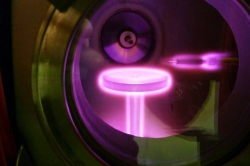Study of the interaction between semiconductor nanoparticles and light is one of the key areas of modern photonics. Very small in size and with distinct optical properties, these particles can be applied in various fields. For example, they can be used as nanoresonators to bring light beams into focus. Scientists from ITMO University have recently found out that such particles placed on a metal surface can serve several functions at once.
“My colleagues and I wanted to investigate the potential applications of semiconductor nanoparticles in medicine and biology”, says Valentin Milichko, a research associate at ITMO University. “Such nanoparticles can localize light on the nanoscale, as well as measure local temperature to within a tenth of a degree. We used these two features in our experiments on silicon and germanium nanoparticles, up to 100-200 nanometers in size. We placed the nanoparticles on a gold film and used this nanostructure to find out how proteins function under extreme conditions, namely when heated by intense light.”
To obtain information about the proteins’ temperature and state, the researchers used the light of a certain wavelength and then analyzed the spectrum of the scattered light.
“Scattering spectra contain information about the nature of the molecules’ chemical structure. Looking at the spectral shift, we can see if the protein still functions properly after being exposed to high temperatures,” adds Mr. Milichko.
The researchers have also found out that certain nanoparticles, such as germanium nanoparticles, can increase the proteins’ heat resistance. The stabilizing effect of these nanoparticles, along with good biocompatibility, makes them potentially useful in medicine. For example, they can be introduced into the body to destroy cancer cells or to visualize molecular interactions in living cells.
“In recent years, there has been a growing interest in the study of resonant dielectric nanoparticles. They not only localize light on the nanoscale but also have many other distinct features. For example, they can be used to measure the local temperature of any nanoobjects, including biological ones,” notes Sergei Makarov, head of ITMO’s Laboratory of Hybrid Nanophotonics and Optoelectronics.
Reference: The conformation of BSA adsorbed to the surface of single all‐dielectric nanoparticles following light‐induced heating. Andrei A. Krasilin et al. Journal of Biophotonics, Feb. 28, 2018.





